Wireless sensor network consists of spatially distributed autonomous sensors to monitor physical and environmental conditions such as temperature, heat and pressure. The main drawback of wireless sensor network is the constraints in energy resources and each sensor node consists of processing unit with limited computational power and limited memory. To overcome these limitations of wireless sensor network, analysis of various routing algorithms done and Energy efficient path created in the network.
Keywords |
| Clustering, wireless sensor, networks, energy consumption |
INTRODUCTION |
| Recent advances in micro electro mechanical systems, technology and wireless communications have led to small
and low cost sensor network. The sensor network may comprise much application area such as health monitoring,
environmental monitoring including temperature, humidity, lightning condition, pressure etc. Additionally, many
domain applications such as factory automation, chemical pollution monitoring, oil and gas remote monitoring,
building sensor and security adopt sensor computing. |
| A Wireless sensor network consists of tiny sensor nodes which has three basic components: a sensing
subsystem for data acquisition from the physical surrounding environment, a subsystem for local data processing and
storing a wireless transmission subsystem for data transmission. Furthermore, a battery is critical for a sensor node. All
the sensors send data that they have sensed from the given region to the base station. The very important issue in this
action is energy efficiency of the network. |
| A wireless sensor network may consist of hundreds of sensor nodes. During the communication process, the sensor
nodes exchange information and discover the neighbouring nodes easily. |
EXISTING WORK |
| Clustering is the technique which is useful for applications requiring scalability to hundreds or thousands
of nodes. The term scalability describes the requirement for load balancing and efficient resource utilization. The
natural candidate for clustering is the application that requires the efficient data aggregation. The clustering can also be
employed by routing protocols. The vital role in sensor node clustering is to choose a set of cluster heads among the
nodes in the network, and cluster the rest of the nodes with these heads. |
| The cluster architecture allows for better resource allocation and enhances the power control. It
balances with different network sizes and node densities under energy constraints. |
| Low Energy Adaptive Clustering Hierarchy (LEACH): The LEACH protocol is a hierarchical protocol in which
most nodes transmit to cluster heads. The operation of the LEACH protocol consists of two phases: |
| The Setup Phase: In the setup phase, the clusters are organised and the cluster heads are selected. The cluster
heads aggregate, compress and forward the data to the base station. Each node determines whether it will become a
cluster head, in thus round by choosing a stochastic algorithm at each round. If a node becomes a cluster head for one
time, it cannot become cluster head again for P rounds, where P is the desired percentage of cluster heads. Thereafter,
the probability of a node to become a cluster head in each round is 1/P. This rotation of cluster heads leads to a
balanced energy consumption to all the nodes and hence to a longer lifetime of the network. |
| The Steady State Phase: In the Steady State Phase, the data is sent to the base station. The duration of the steady state
phase is longer than the duration of the setup phase in order to minimize overhead. Moreover, each node that is not a
cluster head selects the closest cluster head and joins that cluster. After that the cluster head creates a schedule for each
node in its cluster to transmit its data. |
| The main advantage of LEACH is that it outperforms conventional
communication protocols, in terms of energy dissipation, ease of configuration, and system lifetime/quality of the
network. Providing such a low energy, wireless distributed protocol will help the way in a WSN. However, LEACH
uses single-hop routing where each node can transmit directly to the cluster-head and the sink. Therefore, it is not
recommended for networks that are deployed in large regions. Furthermore, the dynamic clustering may results to extra
overhead, e.g. head changes, advertisements etc., which may diminish the gain in energy consumption . |
PROBLEM FORMULATION |
| Task is to study, simulate and compare various routing algorithms used in wireless sensor networks,
clubbed with some placement algorithms such that they can address the following problem:
Given a remote rectangular field, the tasks is establish a sensor network, having its base station at centre, with some
sensor node placement and following a certain routing protocol, such that it can monitor fixed or randomly generated
targets and report the targets to the base station, consuming less power & maintenance and without compromising with
the performance. |
PROPOSED METHOD |
| Routing in wireless sensor network is a demanding task. This demand has led to many routing protocols. Most of
these protocols find the minimum energy path or the shortest path routing. Always using these paths will soon make
those nodes to lose Multipath routing will distribute the traffic among multiple paths instead of routing through a single
path. The proposed plan in this article is to first find out the neighbor node list and then to find the multiple path from
the neighbor nodes. The data packets are distributed through the multiple paths to the destination. The work is been
divided into 4 stages: |
| (I) Initialization stage |
| (ii) Finding neighbor nodes |
| (iii) Finding multipath |
| (iv) Maintenance stage |
(i)Initialization Stage |
| In this stage, the nodes are first clustered and the “HELLO” packet message is send to all the nodes. The node which
has more energy is elected as cluster head (CH). The remaining nodes are treated as member nodes of that cluster. The
node which has the next energy level to the cluster head is treated as next CH. In situation like when the cluster head
loses its energy level below the threshold value, then the next CH will act as the cluster head and the current head goes
to sleep mode. When the system starts its eration, regular nodes send out collected data to the cluster head, and then
the cluster head forwards data to the base station through its neighboring cluster heads using the dynamic routing
mechanism to save energy. Clustered wireless sensor network sending the data, the cluster head may lose some energy. |
(ii) Finding neighbor nodes |
| Before finding the multipath, create a neighbor table for the source nodes. The steps are as follows: max node -number
of nodes in the network x, y -positions of the current node id –node number – threshold energy |
| R- Residual energy of the node |
| G node – nodes within the transmission range of current node |
| Trans range – transmission range |
| The steps are as follows: |
| 1. Get the value of maximum nodes in each cluster |
| 2. Get the position of source node |
| 3. Let the source node be with node id =0 |
| 4. Find the distance between the source node and all other |
| Nodes using the distance formula dis = √ (y2-y1)2 + (x2-x1)2 where (x1, y1) are the positions of the source node
and(x2, y2) are the positions of the node from which the distance is to be calculate. |
| 5. if(dis trans _range) then update the neighbors of the source node in the neighbor list In case if the distance is within
the transmission range and the node energy is greater than the threshold energy then update the neighbor list of the
source node. Consider the following figure.2, node1 is acting as the source and node11 is the destination. |
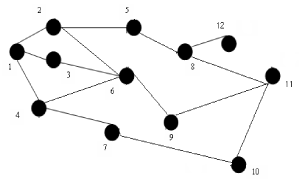 |
| Network model |
| (iii) Finding multipath The next step is to find out the available path for the source to reach the destination in such a
way that no node is repeated in the way. By using the neighbor list all possible paths without any repeated node is
found out. |
| Considering the figure we can get the available path for the source node1 as |
| Node 1->2->5->8->11 |
| Node 1->3->6->9->11 |
| Node1->4->7->10->11 |
| In all these paths no node is repeated or duplicated. Since the data packets are send through 3 different paths there is no
chance for traffic or collision in the network. After finding the path, a RREQ message is send to the destination from
the source. Once when the RREP message reached the source, the source node can deliver its data to the destination
node through the paths. In case, during the iteration of data packets, if the cluster head energy level decreases below the
threshold level, the next CH will act as the CH and the previous node goes to sleep mode. However in due cases, these
paths may even break due to the nature of network topology in sensor network. In order to maintain a reliable network
connection route maintenance is more important. |
(iv) Maintenance stage: |
| When sending the data from the source to destination, there may be any breakage in the route. The node which
discovers the link breakage between two nodes, it sends a route error (RERR) message to the backward direction to the
source node. From the neighbor list table, the source node uses an alternate valid route. |
COMPARISION OF THROUHPUT |
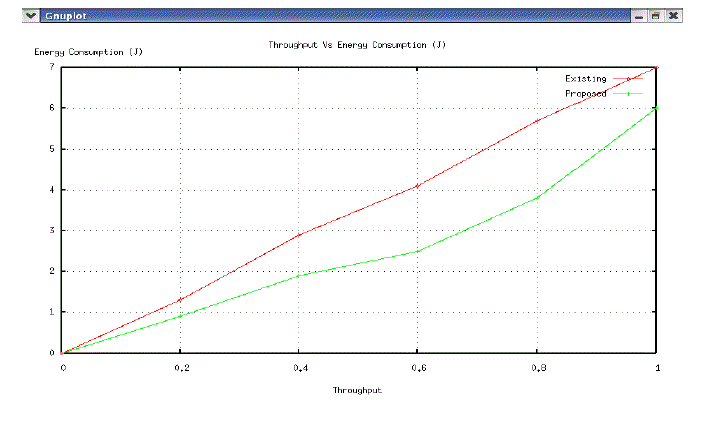 |
COMPARISON OF ERROR OCCURS |
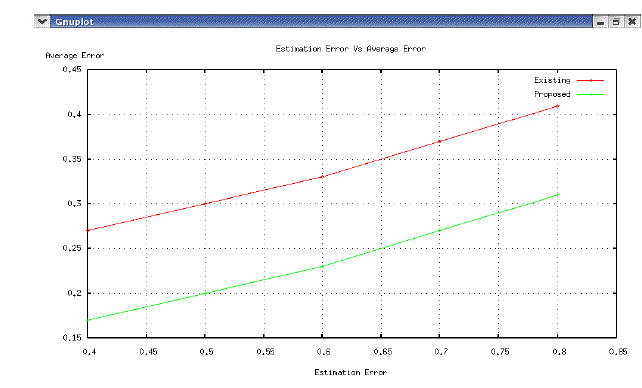 |
PERFORMANCE ANALYSIS |
| The results of the proposed system are compared with the existing shortest path algorithm. The proposed algorithm
proves that it uses only less amount of energy while sending the data. The first graph shows that, for more consumption
of energy, throughput will be high for existing method. The estimated error will be less than average error in the
proposed path shown in the second simulation graph. The graph shows that the total remaining energy is more than the
existing energy. Thus the proposed method is much better in performance comparing with existing method. |
CONCLUSION |
| The introduction of novel method to utilize the energy of the nodes through clustered multipath routing. The energy
efficiency and ease of deployment makes this algorithm a desirable for wireless sensor networks. The simulation result
shows that the energy has been saved, so that the lifetime of the nodes is also increased. There are also future works
would like to focus on, the algorithm has to be further investigated in multipath routing for larger number of nodes. |
| |
Figures at a glance |
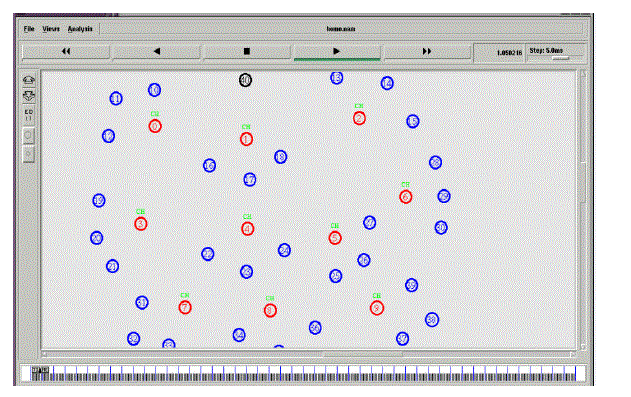 |
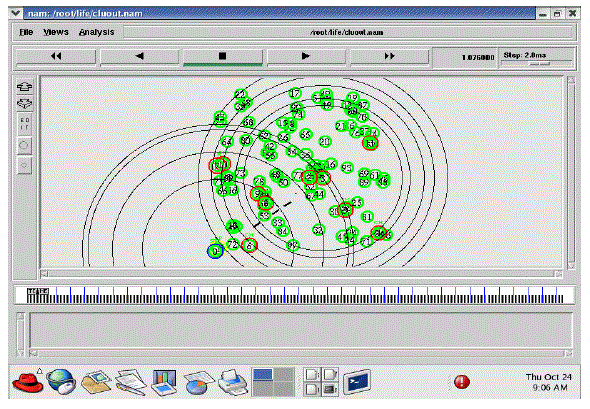 |
| Figure 1 |
Figure 2 |
|
| |
References |
- A. Boukerche , I.Chatzigiannankis and S.Nikoletseas, âÃâ¬ÃÅA New Energy Efficient and Fault Tolerant Protocol for Data Propagation in smart dust Networks using varying transmission rangeâÃâ¬ÃÂ, Computer Communication, Vol 4, No.29, Feb 2008, pp.477
- J.Gao and L.Zhang âÃâ¬ÃÅLoad Balanced short Path Routing in Wireless NetworksâÃâ¬ÃÂ, Proc, IEE INFOCOM âÃâ¬Ãâ¢04 2004, pp. 1099-1108,
- J.Lian, K.Naik and G.B.Agnew, âÃâ¬ÃÅData Capacity Improvement of wireless sensor networks using non-Uniform sensor distributionâÃâ¬ÃÂ, IntâÃâ¬Ãâ¢l Distributed Sensor NetworksâÃâ¬ÃÂ, Vol2. No.2, 2006, pp.121-145
- S.Singh and C.Raghavendra âÃâ¬ÃÅPAMAS:Power Aware MultiAccess protocol with signaling for Ad-hoc NetworksâÃâ¬Ã ACM Computer Communciation Vol.28 No.3, July 1998, pp5-26
- W.Ye.J.Heidenmann and D.Esteing âÃâ¬ÃÅAn Energy Efficient MAC Protocol for wireless sensor networkâÃâ¬Ã in Proceedings of IEEE INFOCOM, NewYork, June 2002.
- Di Tian and Nicolas D. Georganas,âÃâ¬Ã A Coverage- Preserving Node Scheduling Scheme for Large Wireless Sensor NetworksâÃâ¬ÃÂ, iSENSE Project, Communications and Information Technology Ontario (CITO), 2002, pp.32-41.
- L.Doherty, L.ElGhaoni and K.S.J Pister, âÃâ¬ÃÅConvex position estimation in wireless sensor networksâÃâ¬Ã in Proc, IEEE INFOCOM April 2001, pp.1655-1663.
- Y.Shang, W.Ruml, Y.Zhang and M.P.J.Fromherz, âÃâ¬ÃÅLocalization from mere connectivityâÃâ¬Ã in ProcMobilComm, June 2003, pp.201-212
- 9.W.R.Heinzelman, A.P. Chandrakasan, H.Balakrishnan, âÃâ¬ÃÅAn Application specific protocol architecture for wireless micro sensor networksâÃâ¬Ã IEEETransactions on Wireless communication, pp.660-670, 2004.
- M.Kochhal, L.Schwiebert, S.Gupta, âÃâ¬ÃÅRole base hierarchical self organization for wireless ad-hoc sensor networksâÃâ¬Ã in Proc, of second ACM International Workshop on wireless sensor networks and applications (WSNA âÃâ¬ÃË03âÃâ¬Ã ACM Press, 2003.
- S.Bandyopadhyay and E.J.Coyle, âÃâ¬ÃÅMinimizing communication Costs in hierarchically clustered networks of wireless sensorsâÃâ¬ÃÂ, Computer Networks, Vol. 44, no.1, pp.1-16, 2004.
- Y.Ma and J.H.Aylor, âÃâ¬ÃÅSystem Lifetime Optimization for heterogeneous sensor networks with a hub-spoke Topology âÃâ¬ÃÂ, IEEE Trans. Mobile computing, Vol.3, no.3, pp.286-294, 2004.
- Jing Yang 1,2,*, Mai Xu 3,4, Wei Zhao 4 and BaoguoXu.âÃâ¬Ã A Multipath Routing Protocol Based onClustering and Ant Colony Optimization for Wireless Sensor Networks âÃâ¬ÃÅArticle, Sensors 2010, 10, 4521- 4540
- S.Sero and W.Heinzleman, âÃâ¬ÃÅProlonging the Lifetime of wireless sensor networkâÃâ¬Ãâ¢s via unequal clusteringâÃâ¬Ã Proc IEEE International Parallel and distributed Processing Symposium, NewYork, 2005.
|